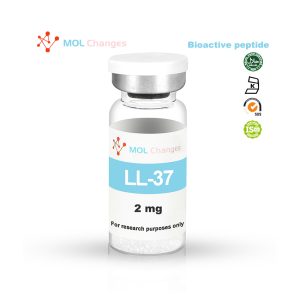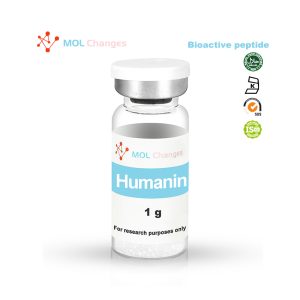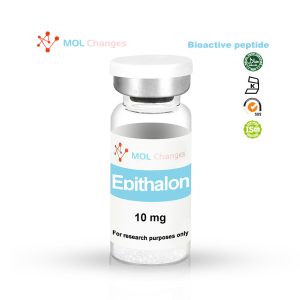Oxytocin is best thought of as a protein with two separate natural functions. First, it is a neuropeptide released by the hypothalamus that plays an important role in bonding, sexual reproduction and childbirth. However, oxytocin is also a standard blood hormone, produced by the placenta in pregnant women, which has implications for labor, milk production, and relationships with newborns. In males, small amounts of oxytocin are produced in the testes and play a role in mating behavior and mate bonding.
Sequence
Cys(1)-Tyr-Ile-Gln-Asn-Cys(1)-Pro-Leu-Gly
CAS Number
50-56-6
Molecular Formula
C43H66N12O12S2
Molecular Weight
1007.193
oxytocin Related research
The role of oxytocin in wound healing
Oxytocin can actually modulate inflammation by acting on certain inflammatory cytokines. An interesting experiment looked at wound healing rates in 37 couples and found that social interactions leading to elevated oxytocin levels actually increased wound healing rates. The higher the oxytocin levels, the faster the wounds healed. A similar study found that hostility in relationships, especially between couples, reduced wound healing rates by as much as 40%. These couples also exhibited lower levels of IL-6, tumor necrosis factor α, and IL-1β at the wound site.
Studying the effects of oxytocin on cardiovascular risk
Based on its ability to increase the rate of wound healing and regulate inflammatory cytokines, researchers hypothesized that oxytocin may also play a role in protecting the heart and vascular system. The peptide has been found to help reduce fat mass, improve glucose tolerance, lower blood pressure and relieve anxiety. All of these are important factors in cardiovascular disease (CVD), so it is not unreasonable to think that oxytocin may be a useful adjunct to existing CVD treatments.
There is also good evidence that in some cases atherogenesis occurs as a result of inhibition of oxytocin receptor expression. Increasing oxytocin levels in people with reduced receptor density maintains cardiovascular integrity and in some cases reverses atherosclerosis.
Studies in rats have shown that infusion of oxytocin directly into the heart during ischemia (e.g., heart attack) protects cardiomyocytes (heart muscle cells) from death. According to Jankoski et al. et al, chronic oxytocin treatment prevents the late development of dilated cardiomyopathy and may help precondition cardiac stem cells to aid in “tissue regeneration through direct differentiation, secretion of protective and cardiomyogenic factors, and/or their fusion with damaged cardiomyocytes.
Other studies on mice have shown that oxytocin treatment reduces heart damage associated with diabetes. In these mice, oxytocin helped reduce body fat accumulation by 19% and lowered fasting blood sugar levels by 23%. It appears to produce these effects by reducing insulin resistance. In this study, mice treated with oxytocin had less systolic and diastolic dysfunction than the control group, which led to reduced cardiomyocyte hypertrophy, fibrosis, and apoptosis.
Oxytocin actually seems to prevent ischemic damage in many tissues and may not be strictly active in cardiac tissue. Studies in rats with abnormally erect penises (sustained erections) have shown that administration of oxytocin prevents ischemia-reperfusion injury by reducing nitric oxide levels.
Diabetes management
Oxytocin may increase glucose uptake by bones by increasing insulin sensitivity, thus making it potentially useful for the treatment of diabetes. Studies in mice have also shown that oxytocin plays an important role in lipid utilization, reduction of systemic fat mass and incidence of dyslipidemia. Oxytocin deficiency has been shown to lead to obesity even in the presence of normal food intake and exercise activity, suggesting that the peptide plays a key role in energy homeostasis.
Interestingly, studies on lean and obese mice have shown that oxytocin treatment has no effect on glucose, insulin, or body composition in lean mice. It appeared to affect these parameters only in obese mice, suggesting that while the peptide can be used to treat some aspects of diabetes, it may not be appropriate in all cases. Oxytocin appears to have a different effect on diabetes than it does in the absence of diabetes. In a study of diabetic patients, intranasal oxytocin lowered glucose and insulin levels and resulted in a 9-kilogram weight loss over an eight-week trial. type 2 diabetic patients had lower circulating oxytocin compared to normoglycemic subjects and it was negatively correlated with glycated hemoglobin A1C and insulin resistance,” Barengolts said.
Cognitive performance
It has long been known that maternal deprivation in early childhood may lead to permanent changes in cognitive and behavioral functioning that may last a lifetime. Studies in mice suggest that this may be a result of changes in oxytocin due to reduced bonding. In one study, maternally deprived mice were treated with oxytocin and found improved levels of the hormone associated with the development of neurons in the prefrontal cortex. No overall differences in behavior were seen, but there was a trend toward better cognitive performance in the oxytocin group. Other studies on mice have found similar results, with intranasal oxytocin improving learning in a non-statistically significant way in stressful situations.
Oxytocin research and anxiety
There is a large body of evidence suggesting that oxytocin may be associated with anxiety and depression. For example, research suggests that genetic polymorphisms in the oxytocin receptor gene may contribute to social anxiety disorder and attachment problems in childhood. Epigenetic changes in the oxytocin receptor were also observed in a study of untreated socially anxious patients, suggesting a possible compensatory mechanism for pathologically reduced oxytocin levels. This, in turn, suggests that social anxiety may be partly a product of diminished oxytocin signaling.
An extreme form of social anxiety disorder, known as borderline personality disorder (BPD), has also recently been linked to oxytocin dysregulation.BPD is associated with hypervigilance to threats, extreme distrust, and altered nonverbal social behavior. Intranasal oxytocin injections in patients with BPD have been shown to alter these behaviors. Borderline Personality Disorder is notoriously difficult to treat and can have significant short- and long-term impacts on quality of life, so the opportunity to gain even a glimmer of understanding of the pathology that contributes to this condition can help put researchers on the path to improving the lives of Millions of Lives.
Oxytocin Research and Hunger
Studies of disorders characterized by uncontrolled appetite (Pridwilliam’s syndrome) have shown that at least part of the pathology is due to increased inhibition (higher than normal levels) of oxytocin signaling. There is now reason to believe that oxytocin plays a role in the regulation of hunger and may even play a direct role in eating behavior.
Oxytocin and old muscles
A new finding suggests that oxytocin is a key component of healthy muscle maintenance and repair, and that a decline in oxytocin signaling with age contributes, at least in part, to age-related muscle atrophy (sarcopenia). This study, conducted at Berkeley, showed that blood oxytocin levels decline with age, as does the number of oxytocin receptors on muscle stem cells. However, the use of oxytocin can reverse this effect in just a few days, restoring much of the muscle’s healing potential. This is important because catabolism and repair are natural processes that maintain and build muscle. Elabd, one of the study’s authors, said that after oxytocin injections, “muscle repair in older mice was about 80 percent of that in younger mice.” It is hoped that oxytocin may provide a meaningful way to intervene in age-related organ degeneration, thereby slowing down dysfunction.
COA
HPLC
MS
- [1] J.-P. Gouin et al., “Marital behavior, oxytocin, vasopressin, and wound healing,” Psychoneuroendocrinology, vol. 35, no. 7, pp. 1082–1090, Aug. 2010. [PubMed]
- [2] J. K. Kiecolt-Glaser et al., “Hostile marital interactions, proinflammatory cytokine production, and wound healing,” Arch. Gen. Psychiatry, vol. 62, no. 12, pp. 1377–1384, Dec. 2005. [PubMed]
- [3] A. B. Reiss, D. S. Glass, E. Lam, A. D. Glass, J. De Leon, and L. J. Kasselman, “Oxytocin: Potential to mitigate cardiovascular risk,” Peptides, vol. 117, p. 170089, Jul. 2019. [PubMed]
- [4] P. Wang et al., “Therapeutic Potential of Oxytocin in Atherosclerotic Cardiovascular Disease: Mechanisms and Signaling Pathways,” Front. Neurosci., vol. 13, p. 454, 2019. [FIN]
- [5] M. Jankowski, T. L. Broderick, and J. Gutkowska, “Oxytocin and cardioprotection in diabetes and obesity,” BMC Endocr. Disord., vol. 16, no. 1, p. 34, Jun. 2016. [PubMed]
- [6] E. Plante et al., “Oxytocin treatment prevents the cardiomyopathy observed in obese diabetic male db/db mice,” Endocrinology, vol. 156, no. 4, pp. 1416–1428, Apr. 2015.
- [7] E. Kolukcu et al., “The effects of oxytocin on penile tissues in experimental priapism model in rats,” Int. Urol. Nephrol., vol. 51, no. 2, pp. 231–238, Feb. 2019. [PubMed]
- [8] C. Ding, M. K.-S. Leow, and F. Magkos, “Oxytocin in metabolic homeostasis: implications for obesity and diabetes management,” Obes. Rev. Off. J. Int. Assoc. Study Obes., vol. 20, no. 1, pp. 22–40, 2019. [PubMed]
- [9] J. Altirriba et al., “Divergent effects of oxytocin treatment of obese diabetic mice on adiposity and diabetes,” Endocrinology, vol. 155, no. 11, pp. 4189–4201, Nov. 2014. [PubMed]
- [10] E. Barengolts, “OXYTOCIN – AN EMERGING TREATMENT FOR OBESITY AND DYSGLYCEMIA: REVIEW OF RANDOMIZED CONTROLLED TRIALS AND COHORT STUDIES,” Endocr. Pract. Off. J. Am. Coll. Endocrinol. Am. Assoc. Clin. Endocrinol., vol. 22, no. 7, pp. 885–894, Jul. 2019 [PubMed]
- [11] A. Dayi et al., “Dose dependent effects of oxytocin on cognitive defects and anxiety disorders in adult rats following acute infantile maternal deprivation stress,” Biotech. Histochem. Off. Publ. Biol. Stain Comm., pp. 1–12, May 2019. [PubMed]
- [12] A. Dayi et al., “The effects of oxytocin on cognitive defect caused by chronic restraint stress applied to adolescent rats and on hippocampal VEGF and BDNF levels,” Med. Sci. Monit. Int. Med. J. Exp. Clin. Res., vol. 21, pp. 69–75, Jan. 2015. [PMC]
- [13] M. G. Gottschalk and K. Domschke, “Oxytocin and Anxiety Disorders,” Curr. Top. Behav. Neurosci., vol. 35, pp. 467–498, 2018. [Europe PMC]
- [14] C. Ziegler et al., “Oxytocin receptor gene methylation: converging multilevel evidence for a role in social anxiety,” Neuropsychopharmacol. Off. Publ. Am. Coll. Neuropsychopharmacol., vol. 40, no. 6, pp. 1528–1538, May 2015. [PubMed]
- [15] M. Brüne, “On the role of oxytocin in borderline personality disorder,” Br. J. Clin. Psychol., vol. 55, no. 3, pp. 287–304, Sep. 2016. [PubMed]
- [16] D. Atasoy, J. N. Betley, H. H. Su, and S. M. Sternson, “Deconstruction of a neural circuit for hunger,” Nature, vol. 488, no. 7410, pp. 172–177, Aug. 2012. [Nature.com]
- [17] S. Yang, M. R. June 10, 2014July 9, and 2015, “‘Trust hormone’ oxytocin helps old muscle work like new, study finds,” Berkeley News, 30-Nov-2001. [Berkeley]
Article/Literature Citation Notes
The purpose of quoting the scientist and professor's article is to acknowledge, recognise and applaud the exhaustive development work that has been done to undertake this peptide research. The scientist does not in any way support or advocate the purchase, sale or use of this product for any reason, and MOL Changes has no affiliation or relationship, implied or otherwise, with the scientist.
warning
These products are intended for scientific purposes only for in vitro research and are not to be used for human, animal or unethical experiments, in vitro research (Latin: in glass) is conducted in vitro. These products are not drugs and are not approved by the Food and Drug Administration in any country for the prevention, treatment or cure of any medical condition, disease or illness. The introduction of this product into humans or animals in any form is strictly prohibited by law.






